11 May 2020
Interview
ELINA JUOPPERI ON FALLING IN LOVE WITH SPACES
Artist Elina Juopperi has recently completed a three-month air_frankfurt residence at Basis ending with the Project Space exhibition, in context of a bi-annual residency exchange between HIAP and Basis.
In her work, Elina combines different working methods such as photography and video production as well as text and object-based installations, performative files and artist books.
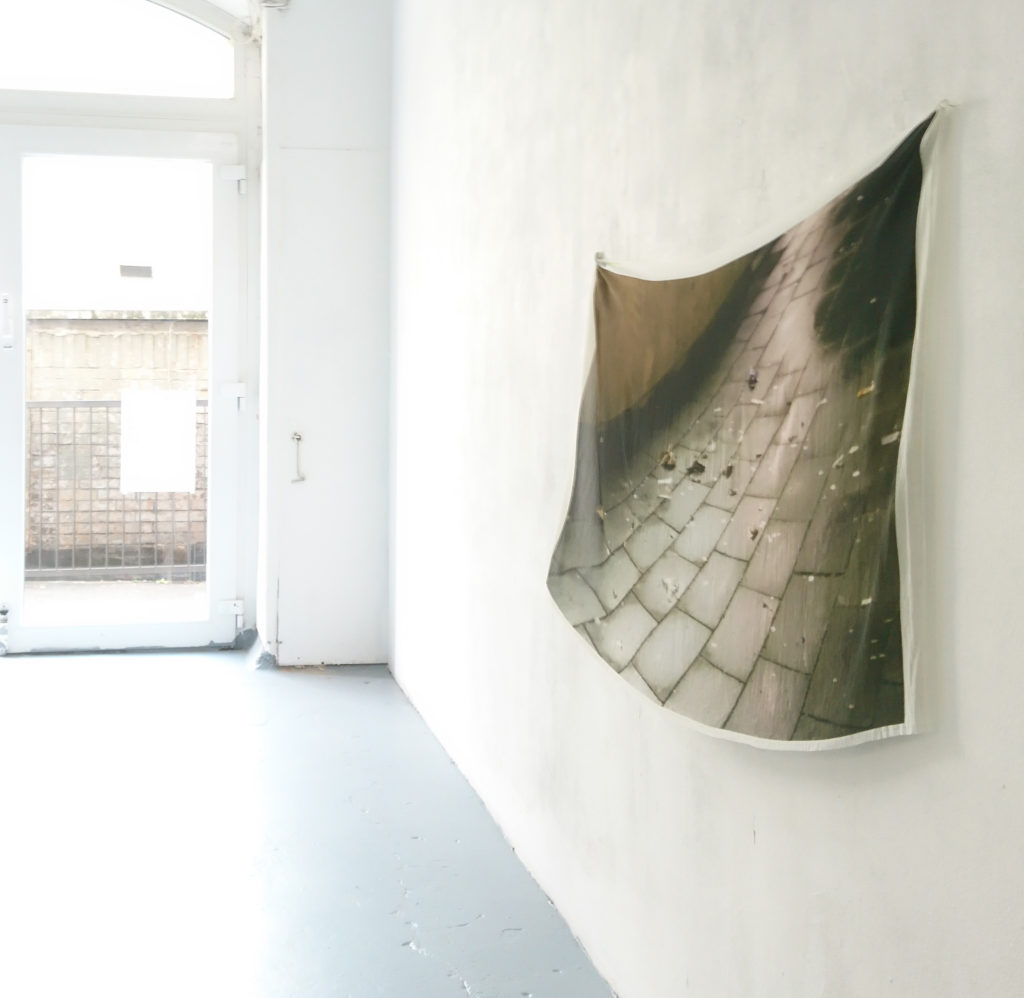
No title, digital print on silk, 2020, air_frankfurt residence at Basis.
AA: You have recently completed a three-month air_frankfurt residence at Basis. Do you enjoy the freshness of new spaces as a key element of your working practice to inspire new works?
EJ: First of all, I would separate the term space from an environment or locality. For me, they are two different things. Let’s call the latter surroundings with everything that comes with it: culture, landscape, language, climate, habits etc, whereas space is a physical dimension with its characteristics, such as a room, a hall, a street. Yes, very strong yes, the possibility to be in a new surrounding is a key element of my working methods. I do not believe in exoticism in art, yet I must admit that seeing, living and learning new cultures influences my works and often it is a motor for new works. My work is documentary, since I am not interested in my personal life, I need to get out to the world to be able to work.
What it comes to space, in this sense Basis was a very interesting opportunity. It was the first time in my life that I actually had a studio space. I have been obliged to work at home until now. I do believe that the space you work at influences the works you create. A simple example: I used to live (for 13 years) in a 11 m2 flat in Paris and I believe – therefore – most of my works at that time were video or photography, something that I could create on my laptop. Basis woke up certain desires or directions in my work which I didn’t have time to develop, but I know those needs are now burgeoning. When I first arrived at Basis and saw my nice studio – a separate space from the flat – it was not only exciting but a little bit scary too. It forced me to face questions of my own capacities as an artist: to face the time, but also the empty space. It is taken for granted, when you give a space to an artist, that she is able to blow some life, to create. But it is not easy, it is not easy to stand in front of emptiness and to be able to create something new from nothing. It also raised some very basic practical questions such as in which shoes I should work. The shoe question might sound funny, but it revealed how important it is to be grounded, to have a solid yet flexible grip on the ground.
AA: Do you think your works collectively have themes that you’re interested in, and if so, what are they?
EJ: I would’ve said ten years ago that I worked mainly on environmental issues, but the past ten years I have worked more on cultural issues and social phenomena. I would say my work is a documentary. There is always a phenomenon (global warming) or an event (somebody threw a plastic mug to the street) behind my works. I get the ideas by reading news, walking in the streets, talking to people, reading books. I’mnot very good at defining my collective topic with words. Some of my individual pieces might look very different, but I still feel that thecollective body is unified, up to the point that I get frustrated of repeating myself.
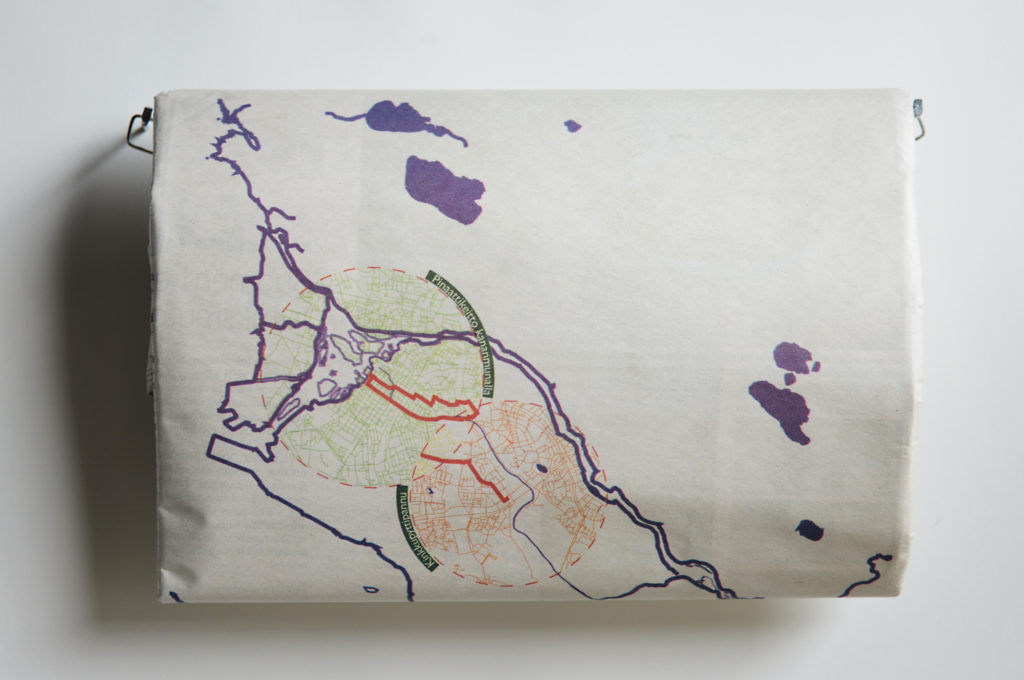
City Within a Plate / walk, lunch, calory counter; in the work a city is measured according to the calory consumption while walking / Oulu version was visualised with two maps, one in newspaper, the other was in pedestrian underpass / 2018. Originally work created for Arte Actual, off / Habitat III, Quito, 2016.
AA: A lot of the work you create is site-specific. How do you approach looking at a space and determining what to make for it?
EJ: I’m very sensitive to spaces, some of them are so exiting that they make my imagination go wild – I do fall in love with spaces. It’s the space that makes me see things. I understand spaces and I can read them easily; they influence me strongly. I’m often upset with Finnish urban or semi-urban areas: there are so many cheap, bad or non-spaces in public areas! When people don’t understand why I react so strongly in every street corner I try to explain that for me it’s visual noise, equal to a strong loud siren that would go on day after day.
Some other works are perhaps not properly speaking site-specific but rather works that have a skeleton which I then adapt each time to the specific space. Instead of forcing the space for the work I adjust the work to the space. I don’t know if it’s good or bad. What I’m taking into consideration are solid things as height, but I might change things such as the colour of the wall. I would say that it is the space that works me.
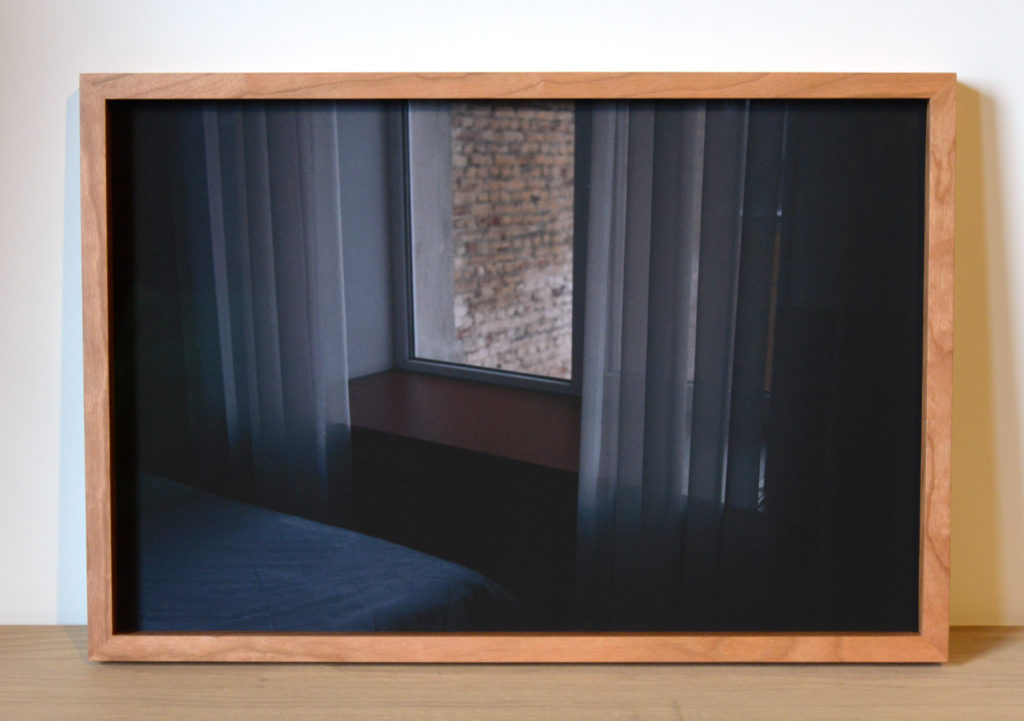
No title, digital print on Hahnemühle paper, 2018.
AA: Temporality seems to also be inherent in your practice. Many of your works are ongoing or take place over several years. Are you interested in the idea of people interacting with them during the process?
EJ: My first reaction was to say no, no I’m not interested. Yet, during my student years I did many works where I offered people a possibility or even invited them to interact with the works such as planting seeds, drawing lines or enabling them to set a fire and, thus, radically change the small sculpture. It was strongly related to the way museums were or how we were supposed to act in museums or galleries. They were very straightforward propositions. At some point, I just grew out of it. I guess something of that period remained, today I don’t even think of it. Perhaps I could consider interaction being like a tool or technique – similar to, let’s say, woodcarving or printmaking – which I acquired during student years and which I occasionally use, but it is no longer the aim of the work. It’s a good question: it seems that I end up – malgré moi– having people interacting some way such as by donating a raanu. Actually, this interaction follows me as a phantom, in most of my shows there has always been a work stolen, damaged or destroyed by spectator(s). This has not been my intention.
I would like to point out that partly temporality is chosen, partly it’s due to the lack of funding. Sometimes the things I do are just time consuming or I’m looking for some specific object and before I find it, it takes years. In other cases, I start the project despite the lack of funding, and then keep working on it with the possibilities I have. Sometimes it takes many years before I get them done. With proper funding I could have created them in a reasonable time span. Therefore, the residencies which do not only offer a living grant but a production grant as well are very fruitful, because you can actually test and try in a short time span. There is lots of liberty if you are given money and space (to work and to show), yet there are no big expectations. You can try, see and learn.
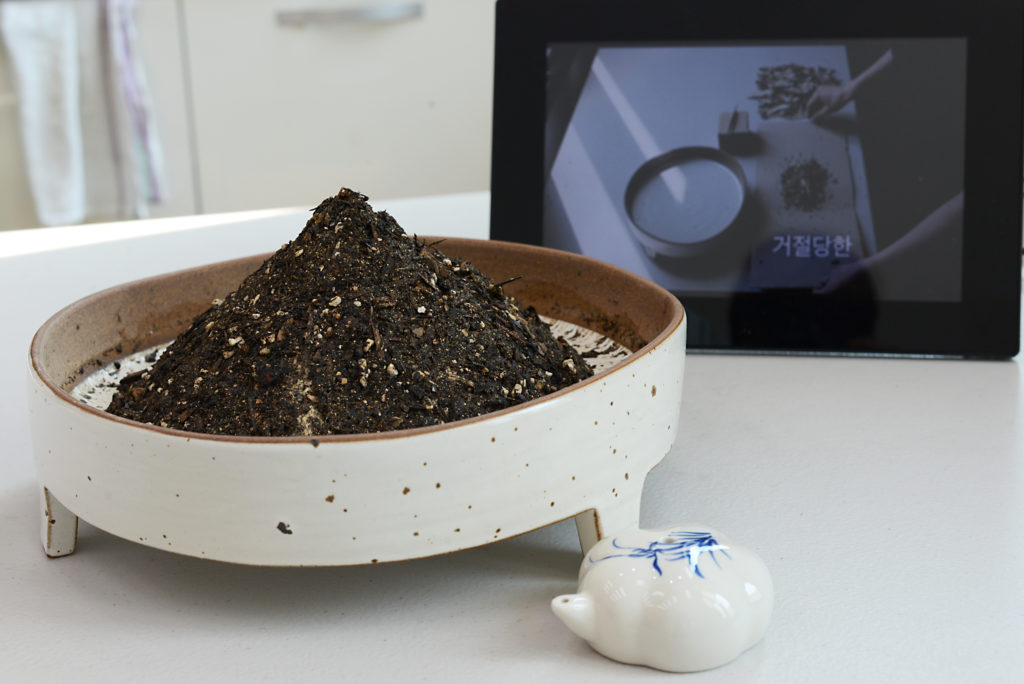
Rejected / disregarded seeds, black soil, water, ceramics, video displaying the selection process of seeds. In the work disgregarded and finally planted seeds are watered regularly / 2018. Sema Nanji residency, Seoul / Finnish Cultural Foundation.
AA: How important do you feel it is for you to work with a range of media?
EJ: I could not see it another way. This is because it is my subject or topic that calls for a certain media. At the same time the variety of media I use is a source of inspiration and frustration. The plurality of media I use has driven me to the situation where I’m not a technical master on any field. I think the frustration of this feeling is partly related – whether there is truth in it or not – to the feeling that, to some extent, in the art world a certain mastery of technique (or subject) is a value per se. This mastery I don’t possess; I might look shallow to some since I keep hopping between medias. I’m not exploring the media’s own inner depth or qualities, but I choose a certain media because I intuitively feel it will best serve my subject. Part of the frustration is related to the painful process of learning. Things are going so slow and you keep getting results that are not perfect, lots of trial and error. Yet this same process of learning is a gift, the person I am needs new challenges and this way I acquire them. It rarely starts with, “Oh, I’d like to learn this new media or technique. What should I do with it?” but rather, “Oh, that’s a situation in the society I disapprove of. How could I bring this topic up?” and then I find myself learning how to make a rope from nettle or something.
AA: How is your process affected by the materials you work with? Can you talk about how you select your materials – how do you source them, what research do you do to understand which materials will give you the physical attributes you desire?
EJ: I ’m not really interested in physical attributes materials give to me but rather what they mean to the society, what they stand for, what they carry with them and so on. If I choose gold, I choose it for the position, role or value it has in the society instead of its physical aspects. This does not mean that I don’t appreciate physical qualities. I can spend hours admiring gold’s visual aspects and its capacity to reflect light, but usually this is not the reason why I would choose it. This question is a bit tricky since I claim to choose the material by its social meaning, yet I easily spend hours, even days to find the right type of rope or something else despite there being no other differences but visual ones. I would say the physical aspects are secondary in the work, yet not lesser. Perhaps materials are some kind of a base rhythm to the topic. The material, or perhaps rather the objects (which are made of certain materials), just feel right when I see it. When I’m unsure, I buy several options – variation of trees or fabric – and I try out how they look in the work or in the space and, then, one of them just says, “It’s me.” Sometimes I do have to accept them, their materiality; I might not like it, but I see it is the thing the work needs. It is really hard to accept something you don’t like, that is hard work. I do read quite a lot about the material, or object before I start the work. Couple of years ago, I read all the books I could get about Finnish coastal artillery, how they were built, where they were disposed of and what were the specs of each weapon. It is definitely not my favourite topic, but I needed to learn more about them before I started my work.
It’s with photography that I’m particularly picky with material. I think the material onto which a photo is printed and how it is printed influences the image. The same image on newspaper paper or on acrylic is not the same image, the materiality adds to the story. In that sense I guess I’m more a visual artist than a ‘pure’ photographer. Even a slight difference between a slightly rough and a totally flat surface has an impact. Therefore, I was really happy to print on silk during the Basis residency. I really wanted silk, to have this airy, shiny result. Especially as the collective understanding of what silk is – value, luxury, clothes (or laundry), natural – added to the piece.
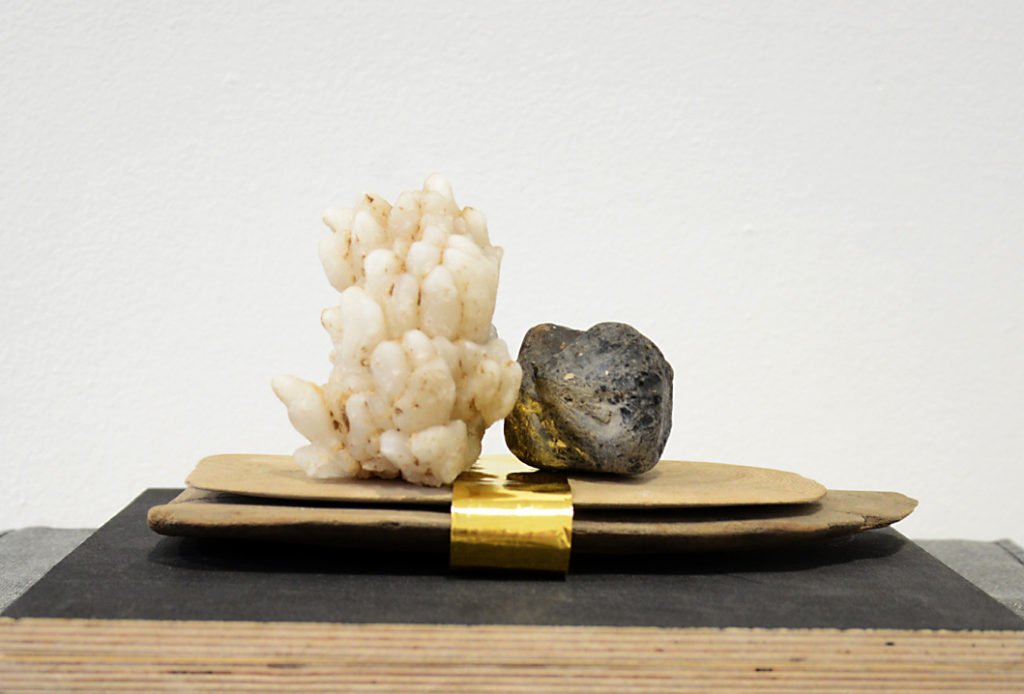
La System de Valeur / wood, stone, 24k gold and salt / 2016-2018.
AA: Your background has played into some of the artworks you have made. How does tradition or your personal history affect the works you create?
EJ: Personal history affects my works or rather working in the sense that, being from North Finland, I find it extremely important that we have museums and cultural events in the smaller towns and ‘remote’ areas. I strongly dislike the idea of centralisation where one or two capitals would be somehow better than smaller towns. The capitals might have more capital and more inhabitants (which is monetised by counting visitors) but, for me, it does not make them more valuable. My personal history has also influenced my works by utilising the nature–culture axiom; this is related to my childhood in Kolari and my adult years in Paris.
I made a deliberate choice during my studies to work – as well – with subjects that are from my own backyard, meaning topics that are related somehow to (northern) Finland. What I mean with exoticism is that a work does not get better if I travel to the Amazonia to work with deforestation, instead of working with the deforestation in my country. I believe(d) that human societies are at the end very similar, many topics which are local, are also global. If I talk about language loss in northern Finland, I also talk about language loss in France or America. Yet there are certain works that are and stay local, the displacement of the work to another space or surrounding – another context – affects the reading of the works strongly and not always in a beneficial way. It is good to keep this in mind and accept that not everything is transportable. The white gallery space minimises the surroundings, but it does not erase the cultural background, social class and, well, the mind of the people who see the works.
I find the contemporary exchange residency system enriching but I believe artists – our working possibilities, that is – should be supported locally. Because – as I stated – the space, the surroundings, the culture, the language and everything influences the work and, thus, our understanding of the world.
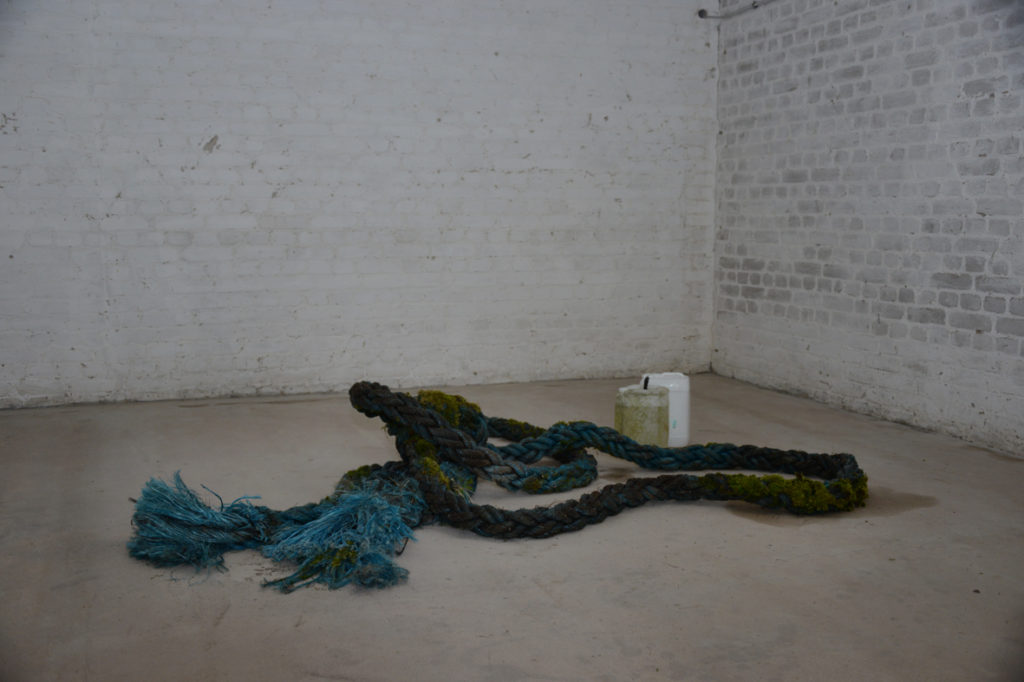
990 years / plastic rope (found), moss, canisters, water / 2016, Örö residency.
Photos provided by the artist.
Read more:
Project Space exhibition at Basis
